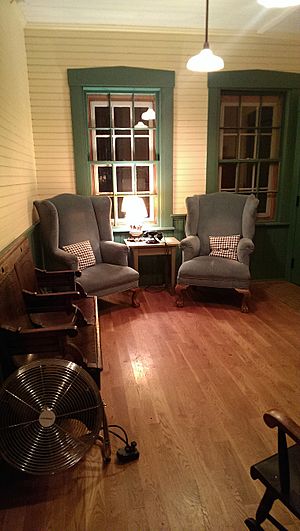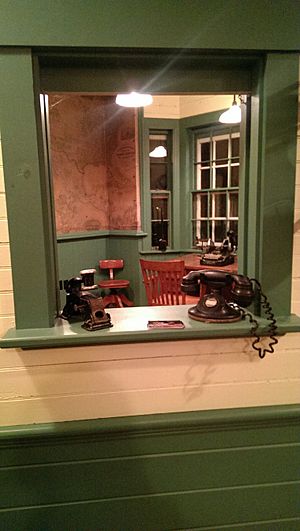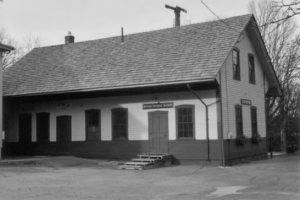Contoocook Railroad Depot facts for kids
Quick facts for kids |
|
|
Contoocook Railroad Depot
|
|

Contoocook Railroad Depot with 1907 passenger coach
|
|
| Location | 896 Main Street, Contoocook, NH 03229 Off NH 103 and NH 127 Hopkinton, New Hampshire (village of Contoocook) |
|---|---|
| Built | 1849-50, renovated 1999–2013 |
| Architectural style | Mid-Nineteenth Century Two Story Wooden Frame |
| Website | www.contoocookdepot.com |
| NRHP reference No. | 06000131 |
| Added to NRHP | March 16, 2006 |
The Contoocook Railroad Depot is an old train station in Contoocook, New Hampshire. It was finished in 1849. This makes it one of the very first big train stations built west of Concord. It was part of the Concord and Claremont Railroad line.
This building is special because it's one of the best-preserved train stations from the early days of railroads in New Hampshire. It shows what train stations looked like when trains were just starting to become popular. The depot has a classic Greek Revival style of architecture. It's an important piece of history for how train stations developed.
Contents
Why This Old Train Station Is Special
The Contoocook Depot is unique because it's one of the few train stations from the 1850s that still looks much like it did back then. Many other similar stations from the same time have disappeared. For example, stations that looked almost exactly like it once stood in West Concord and Bradford, but they are gone now. This makes the Contoocook Depot a rare and valuable historical building.
How the Depot Helped the Community
From 1849 until the 1960s, the Contoocook Depot was a very busy place in Contoocook Village. It was more than just a place where people got on and off trains. It was also a center for communication.
Connecting People and Places
The depot handled all the railway mail. For some years, it even served as the local post office. It also had a telegraph office, which allowed people to send messages across long distances. Later, it was one of the first places in the village to get a telephone in 1884.
At first, trains from Contoocook mostly went to Concord. From Concord, travelers could connect to other major cities like Boston and Manchester. Trains also went north to places like West Lebanon and White River Junction, Vermont.
A Busy Village Center
By 1858, Contoocookville was a busy place with many businesses. There were shops for carpenters, a mill for wool, sawmills, and even a carriage shop. The village also had schools. The train depot was right in the middle of all this activity. It was located where two different railroad lines met, making it a key spot for trade and travel.
The depot was also the local office for companies like Railway and American Express. These companies helped send packages and goods. The area around the depot was a small but active hub for train services. It once had many buildings, including a freight house, an engine house for trains, and a woodshed. Most of these buildings are now gone, but the depot and a nearby covered bridge remain.
Saving the Depot: Contoocook Riverway Association
The Contoocook Riverway Association is a group that works to protect the depot and the area around it. This non-profit organization started in 1999. They now own the railroad depot, an old train car, and the land.
Bringing the Depot Back to Life
Between 1999 and 2013, a big project took place to fix up the Contoocook Railroad Depot. The goal was to make it look like it did in 1910. The Contoocook Riverway Association bought the depot from the town for just one silver dollar in 1999.
The restoration cost about $400,000. This money came from government grants and donations from the community. The work took about three years. First, the roof was replaced with wooden shingles, just like the original roof. Then, new siding and paint were added to the outside. Even the old train signal, called a semaphore, was cleaned and painted.
Inside, many original features were saved, like two ticket windows and the old wooden walls and ceilings. Over the years, people from the community have returned many original items to the depot. These include the blue "Contoocook" station sign, a luggage cart, and a seating bench.
In 2007, an old wooden Pullman Passenger Coach (a type of train car) was given to the Association. It was placed on tracks behind the depot, looking as if it's ready to travel again.
What the Depot Is Used For Today
Today, the Contoocook Railroad Depot is a museum and a visitor center. It's open on weekends and some weekdays. In 2013, the second floor was renovated. It now has a meeting room, more museum displays, and a place to keep historical documents. There's even an elevator to help everyone, including those with disabilities, reach the second floor.
See also
- Official website: https://www.contoocookdepot.com/
- National Register of Historic Places listings in Merrimack County, New Hampshire






